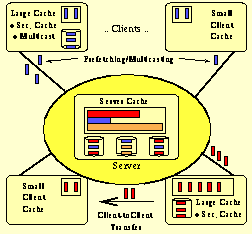Distribution and Caching for Multimedia Data
This project aims at developing high-performance multimedia information-system technology.
This project aims at developing high-performance multimedia information-system technology.
Our focus in this sub-project is on distributed caching strategies for continuous media in application areas such as medical information systems, the virtual campus or news-on-demand. We assume a computing infrastructure consisting of a number of servers and a moderate-to-large number of clients connected by a tightly-coupled cluster of local-area networks. Cumulative client resources may exceed server resources (CPU's, and primary and secondary-memory capacity and bandwidth).
Many data placement and scheduling algorithms for continuous media in single-disk(e.g. scan-EDF) or in multi-disk(e.g. staggered striping) systems are round-based. Round-based schemes assume that retrieval, transmission and display activities are all synchronised on a round-by-round basis. In the architectural context described above, there are a number of grounds for considering round-based schemes too restrictive:
Capacity:
A consequence of being round-based is that round-length must be tuned to the weakest network-connections and clients in the system. That is, the resources of faster connections and of larger clients cannot be fully exploited.
I/O Bandwidth:
Longer round lengths have several advantages for placement and I/O bandwidths. These include reduced overheads due to seek and rotational delays, and increased reward from effective intra-stream data placement strategies.
Mixed Workload:
Multimedia systems must accommodate more than continuous media only: a variety of classes of non-continuous media including images and text must also be accommodated, in addition to structured data and access structures. The assumption that a significant proportion of all resources be set aside for round-based scheduling and processing, therefore, is somewhat restrictive.
For these reasons, we are developing scheduling and caching algorithms between servers and clients which aim to increase the capacity of multimedia servers and systems as a whole through effective use of client resources. The main client resources we consider are primary memory resources, secondary memory resources and secondary memory bandwidth. Particular strategies are:
Prefetching:
That is, the early scheduling and retrieval of continuous data, and client caching. Comparing MPEG-2 bandwidth requirements with those offered by modern disk systems, client caching on secondary storage is feasible.
Multicasting:
Related to prefetching, multicasting is the broadcast of data across the network to all clients which will (at some point) need the data. This also requires large (secondary) caches.
Multi-sourcing:
Given significant prefetching and caching between clients, the possibility to service new client requests from other client caches arises, thereby removing that load from servers.
Implementation tasks within this project are being carried out within the prototype system.
Project Partners:
This project is part of the ESPRIT project (9141) with partners in Greece (MUSIC/TUC), Germany (GMD-IPSI) and Italy (CNR-IEI) and aims at developing high-performance multimedia information-system technology.
Funding:
Our part in this project is funded by the BBW (93.0135), and the project as a whole is funded under the ESPRIT initiative (9141). ETH works, in this project, in close collaboration with Prof. Gerhard Weikum (University of Saarbrücken).
